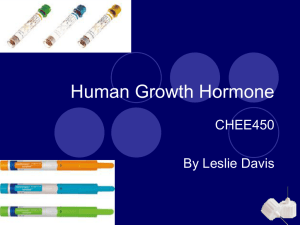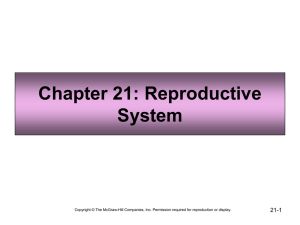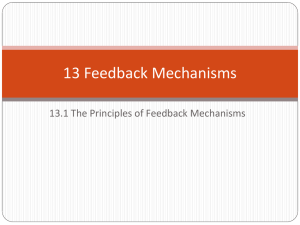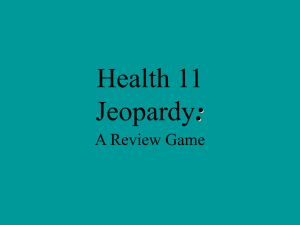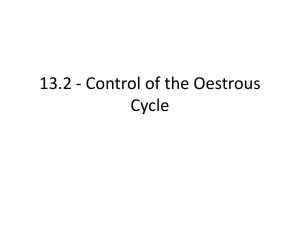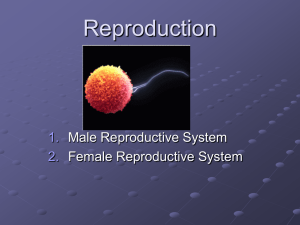Higher Human Biology: Reproduction Past Paper Questions
advertisement
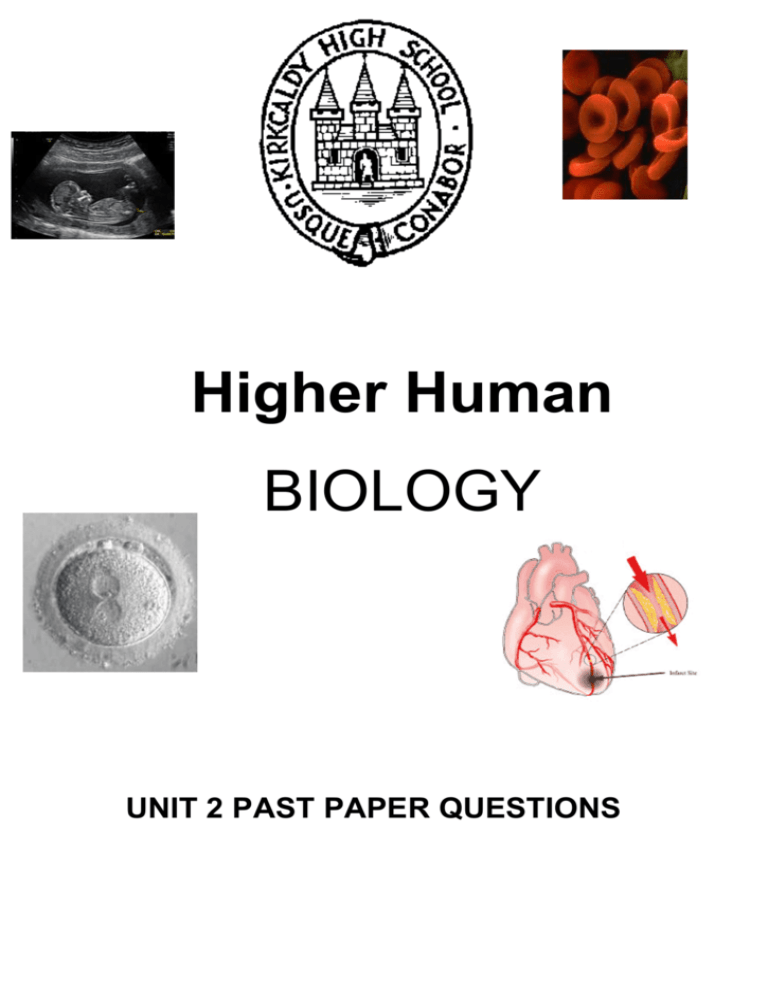
Higher Human BIOLOGY UNIT 2 PAST PAPER QUESTIONS Sub-Unit 1: REPRODUCTION 1. A function of the interstitial cells in the testes is to produce A B C D 2. sperm testosterone seminal fluid follicle stimulating hormone (FSH) The sperm counts of a sample of men taken between 1940 and 2000 are shown in the graph below. What is the average reduction in sperm count per year? A B C D 3. Endometrium Graafian follicle Fertilised ovum Unfertilised ovum Which of the following forms of contraception causes thickening of cervical mucus? A B C D 5. Mini-pill Barrier methods Morning-after pill Intra-uterine device The graph below shows the growth in length of a human fetus before birth. What is the percentage increase in length of the fetus during the final 4 months of pregnancy? 0.67 million/cm3/year 0.75 million/cm3/year 0.92 million/cm3/year 45 million/cm3/year From which structure in the female reproductive system does a corpus luteum develop? A B C D 4. A B C D 6. 33.3 60.0 62.5 150.0 The table below contains information about four semen samples Semen Sample A B C D Number of sperm in sample (millions/cm 3 ) Active sperm (percent) Abnormal sperm (percent) 40 30 20 60 50 30 60 65 75 10 40 70 Which semen sample has the highest number of active sperm per cm3? 2 7. The diagram refers to human reproduction. OVARY 9. TESTIS gamete mother cells gamete mother cells Process X Process X Ovum One function of the seminal vesicles is to A B C D produce testosterone allow sperm to mature store sperm temporarily produce nutrients for sperm 10. The graph below shows changes in the concentration of hormones X and Y in the blood during the menstrual cycle. Sperm Process Y Zygote Process Z Which of the following correctly identifies hormones X and Y? Embryo cells Which of the following correctly identifies processes X, Y and Z? A B C D 8. X Y Z mitosis meiosis meiosis mitosis meiosis fertilisation mitosis fertilisation fertilisation mitosis fertilisation meiosis The diagram below shows a section through seminiferous tubules in a testis. Which cell produces testosterone? Hormone X LH Oestrogen Oestrogen Progesterone A B C D Hormone Y Oestrogen FSH Progesterone Oestrogen 11. Changes in the ovary during the menstrual cycle are described below. 1 2 3 4 5 Corpus luteum forms Ovulation occurs Progesterone is produced Corpus luteum degenerates Graafian follicle develops The sequence in which these changes occur following menstruation is A B C D 2, 3, 1, 5, 4 2, 1, 3, 4, 5 5, 3, 2, 1, 4 5, 2, 1, 3, 4 3 12. The graph below shows the growth in length of a human fetus before birth. 14. The diagram below shows the blood flow in the umbilical cord. Which line in the table below identifies correctly blood vessel X and the blood it carries? What is the percentage increase in length of the fetus during the final 4 months of pregnancy? A B C D 33.3 60.0 62.5 150.0 13. The sperm counts of a sample of men taken between 1940 and 2000 are shown in the graph below. What is the average reduction in sperm count per year? A B C D 0.67 million/cm3/year 0.75 million/cm3/year 0.92 million/cm3/year 45 million/cm3/year A B C D 15. Blood vessel X vein vein artery artery Blood carried in X deoxygenated oxygenated deoxygenated oxygenated Nicotine is a chemical which may affect prenatal development. The diagram shows the stages of development when major and minor malformations of organs may occur if there is exposure to nicotine. Key major malformation minor malformation For how many weeks during pregnancy is there a possibility of major malformations to organs during development? A B C D 6 7 9 13 4 16. The diagram below represents part of the mechanism which controls ovulation. Pituitary Stimulating hormone Inhibiting hormone Ovaries The hormones indicated above are A B C D Stimulating hormone Inhibiting hormone FSH Progesterone Oestrogen LH Oestrogen FSH LH testosterone 17. On which day in the following menstrual cycle could fertilisation occur? A B C D Day 30 Day 17 Day 14 Day 2 5 18. The diagram shows a section through the reproductive organs of a man. (a) (i) State the site of sperm production within the testis. __________________________________ (ii) 1 State one function of the secretions from the seminal vesicles and prostrate gland. ____________________________________________________ ____________________________________________________ (b) (i) (ii) During a male sterilisation operation (vasectomy), a tube is cut. Draw a letter X on the diagram to indicate the likely position of the cut. 1 Why is the transport of testosterone from the testes unaffected by this operation? ______________________________________________________ 1 19. The diagram shows stages in the development of a human embryo from fertilisation to implantation. 6 (a) Name the parts labelled A and B. A ___________________________ B _________________________ 1 (b) What term is used to describe he first few divisions of the zygote? _______________________________________ 1 (c) Name a hormone which is involved in preparing the endometrium for implantation and state where it is produced. Hormone ______________________ Produced by ___________________ 1 (d) What organ will develop from the tissue labelled C? _________________________________________ (e) Sometimes twins develop in the uterus. Distinguish between the formation of monozygotic and dizygotic twins. 1 3 _____________________________________________________________ _____________________________________________________________ _____________________________________________________________ _____________________________________________________________ _____________________________________________________________ _____________________________________________________________ 20. The diagram shows part of the reproductive system of a woman in early pregnancy. (a) Place an X on the diagram to show where fertilisation occurred. 1 (b) Structure P produces progesterone at this stage in pregnancy. 7 (i) Name structure P. _______________________________ (ii) 1 State one function of progesterone during early pregnancy. ____________________________________________ ____________________________________________ (c) 1 Structure Q will develop into the placenta. Name the processes involved in the transfer of oxyen, glucose and antibodies across the placenta. (d) Oxygen ___________________ Glucose ___________________ Antibodies ___________________ 2 In the early stages of pregnancy the cells of the embryo are starting to differentiate. Describe what happens during differentiation. ____________________________________________________ ____________________________________________________ 1 21. (a) Name a stage of embryo development that comes between fertilisation and differentiation. ________________________________ 1 (b) A woman gives birth to monozygotic twins. State whether monozygotic twins are identical or non-identical and give a reason for your answer. Monozygotic twins ___________________________ Reason ____________________________________________________ ____________________________________________________ ____________________________________________________ 1 8 Questions 22 and 23 refer to the following list of hormones. A Follicle Stimulating Hormone (FSH) B Luteinising Hormone (LH) C Oestrogen D Progesterone 22 . Which hormone stimulates the production of testosterone by the testes? 23 . Which hormone is produced by the corpus luteum? 24 . Which of the following will not normally pass through the placenta between the mother and fetus? A B C D 25 . Oxygen Minerals Glucose Red blood cells The flowchart summarises the processes involved in the production of semen. Hormone X LH Tissue Y Testosterone Sperm Mother Cells Structure Z Mature sperm cells Semen SEMINIFEROUS TUBULES (a) Name hormone X and tissue Y. Hormone X _________________ Tissue Y ________________________ (b) Semen contains substances secreted by structure Z. (i) Identify structure Z. __________________________________ 1 9 (ii) Describe how a named substance from structure Z aids fertilisation. Substance __________________________ Description ______________________________________________ ________________________________________________________ 1 (c) Complete the table to show the percentage of each type of cell which would contain a Y chromosome. Cells Percentage of cells containing a Y chromosome Sperm mother cells Mature sperm cells 26 The diagrams represented gamete production in an ovary and part of a testis. (a) (i) Which letter represents a mature ovum? 1 (ii) Identify one labelled part of each organ which is affected by FSH. Letter Name (iii) Describe the effect of testosterone on the testes of an adult. ___________________________________________________ ___________________________________________________ 1 10 (b) Oxytocin is a hormone which is secreted during and after childbirth. (i) State where oxytocin is produced in the body __________________________________ 1 (ii) Synthetic oxytocin can be used to induce labour. Describe how it brings about birth. ______________________________________________________ ______________________________________________________ 27 . 1 The diagram below shows a section of a woman’s breast shortly after she has given birth. (a) (i) Name the hormone that stimulates the secretory glands to start producing milk. ____________________________ 1 (iii) The cells lining the secretory glands are particularly rich in ribosomes. Suggest a reason for this. ______________________________________________________ ______________________________________________________ (b) 1 Fluid is not usually released from the breast until the baby suckles. (i) What name is given to the first fluid that the baby receives from the breast? ______________________________________________________ 1 11 (ii) Describe one way in which this first fluid differs from the breast milk produced a few days later. _______________________________________________________ _______________________________________________________ 1 (iii) Suckling and crying are examples of non-verbal communication used by a baby. Why is non-verbal communication important to both the mother and baby? _______________________________________________________ _______________________________________________________ 28. 1 The graphs below show that plasma concentrations of certain hormones throughout a woman’s menstrual cycle. Graph 1 shows the concentration so FSH and LH. Graph 2 shows the concentration of two other hormones, X and Y. 12 (a) Where in the body are FSH and LH produced? __________________________________________________ (b) 1 Name hormones X and Y. X _______________________ Y _______________________ (c) What is the maximum concentration of hormone Y? _______________ Units 1 (d) On which day did ovulation occur? Give a reason for your answer. Day ______________ Reason ___________________________________________ __________________________________________________ (e) 1 During her next cycle, the woman became pregnant. Describe any differences which would occur in the concentrations of FSH and hormone Y after day 25. FSH ___________________________________________________ 1 13 Hormone Y ______________________________________________ ________________________________________________________ 1 29. The graph below shows the concentration of two ovarian hormones in a woman’s blood during her menstrual cycle . (a) Name hormone X. ________________________________________________________ 1 (b) What effect does oestrogen have on the following structures? (i) The uterus between days 4 and 12 in the cycle. ___________________________________________________ ___________________________________________________ 1 (ii) The pituitary gland on day 12 of the cycle. ___________________________________________________ ___________________________________________________ 1 (c) Describe one way in which the graph would be different if the woman became pregnant during this cycle. _________________________________________________________ 1 14 (d) The diagrams below show sections through two structures found in the ovary at different times in the menstrual cycle. (i) Name structures P and Q P ______________________ Q ___________________ (ii) 1 What key event in the menstrual cycle occurs before P develops into Q? __________________________________________________ 1 15 31 The graph below shows the relative concentrations of three hormones in the plasma of a woman during a normal 28-day menstrual cycle. (a) Name hormone A. __________________________ (b) 1 What is the effect of the sudden increase in concentration of luteinising hormone? __________________________________________________ (c) During which time period is the endometrium likely to reach maximum thickness? Underline the correct answer. 0 – 4 days (d) 1 12 – 16 days 22-26 days 1 In what way would the line showing the concentration of FSH be different if fertilisation took place during this cycle? Give an explanation for your answer. Difference ___________________________________________ ___________________________________________________ 1 Explanation _________________________________________ ___________________________________________________ 1 16 32. The graphs below show changes in the volume and composition of milk produced by a woman in the first week following the birth of her child. Graph 1 – changes in the volume of milk produced Graph 2 – Changes in the concentration of lactose sugar and IgA antibody in milk 17 32. (continued) (a)(i) What name is given to milk produced in the first few days after birth? _____________________________________________________ (ii) 1 From Graph 2, describe two ways in which the composition of milk produced in the first three days after birth differs from milk produced later. 1.______________________________________________ 2. _____________________________________________ (b) 1 What was the volume of milk produced on day 3? _________________ 1 (c)(i) Between days 2 and 3 this woman produced a constant mass of IgA. Explain why the concentration of IgA in her milk decreased during this time. ____________________________________________________ ____________________________________________________ (ii) 1 Express, as a simple whole number ratio, the concentration of IgA compared to the concentration of lactose produced on day 6. (1g = 1000mg) Space for calculation _______:_______ IgA Lactose (d) 1 Using Graphs 1 and 2, calculate the mass of lactose produced on day 5. Space for calculation __________g 1 18 33. The sperm counts of 30 men taken between 1940 and 2000 are shown in the graph below. A line of best-fit has been drawn, to indicate the trend over the 60 year period. (a) Using the line of best-fit, calculate the percentage decline in sperm count over the 60 year period. Space for calculation ___________ % 1 (b) From the graph, what is the maximum sperm count for any one individual recorded during this period? __________million/cm3 1 (c) Some insecticides are thought to influence sperm production. Explain why animals at the end of food chains are more likely to be affected by insecticides. ______________________________________________________________ ______________________________________________________________ 19 ______________________________________________________________ 1 (d) Name the pituitary hormone which stimulates the production of sperm. ________________________________________________ 1 (e) Name a gland which adds fluid to sperm during ejaculation and describe one function of this fluid. Gland _____________________________ 1 Function of fluid _______________________________________________ ____________________________________________________________ 1 (f) Two treatments sometimes used for infertility are artificial insemination and in vitro fertilisation. Describe briefly what is meant by these terms. Artificial insemination __________________________________________ ___________________________________________________________ In vitro fertilisation ____________________________________________ ___________________________________________________________ 34. 2 The diagram below shows the influence of the pituitary gland on testosterone production. Pituitary gland Hormone X produced Testes stimulated Testosterone produced What is hormone X? A. B. C. D. 1 Luteinising hormone Follicle stimulating hormone Oestrogen Progesterone 20 35. Which of the following changes indicate ovulation is likely to have taken place? Cervical mucus 36. A becomes sticky Body Temperature rises B becomes sticky falls C becomes watery rises D becomes watery falls Which of the following describes correctly the exchange of materials between maternal and fetal circulations? A B C D 37. Glucose into fetus by active transport into fetus by active transport into fetus by pinocytosis into fetus by diffusion Antibodies into fetus by active transport into fetus by pinocytosis into fetus by active transport into mother by pinocytosis The diagram below presents the appearance of a testis when viewed under a microscope. (a) Name Structure X: ____________________________________ 1 (b) State which cells are produced in structure X: _______________ 1 (c) What is the name of cells labelled Y? _____________________ 1 (d) Explain the role of cells labelled Y in the production of male sex cells. 21 ___________________________________________________ 38. 1 Luteinising hormone is involved in the control of the menstrual cycle in female mammals. (a) Name the gland which produces luteinising hormone ___________________________________________________ 1 (b) Name another hormone produced by this gland which controls the menstrual cycle ____________________________________________________ 1 (c) Progesterone is a hormone produced from within the ovary. (i) Name the structure from within the ovary which produces progesterone. _______________________________________________ 1 (ii) State one function of progesterone during the menstrual cycle. _______________________________________________ 1 (iii) As the menstrual cycle continues, progesterone levels decrease. State the effect this will have on the uterus. ________________________________________________ 1 39.(a) Decide if each of the following statements about treatments for infertility is TRUE or FALSE and tick () the correct box. If the answer is FALSE, write the correct word(s) in the correction box to replace the word(s) underlined in the statement. Statement If mature sperm are defective or very low in number IVF can be used True False Correction Ovulation can be stimulated by drugs that prevent the negative feedback effect of progesterone on FSH secretion Donor sperm can be used in artificial insemination of the male partner is sterile. 22 (b) The table below refers to semen samples take from five men. (i) (ii) Identify which man has the lowest percentage of normal sperm. Letter: _________________________________________________ 1 A man is fertile if at least 60% of his sperm are normal Identify which man/men is/are infertile. 1 Letter(s): _______________________________________________ 40.(a) A variety of techniques can be used to monitor the health of the mother and the developing foetus. State what each of the following is used for: (b) (i) Ultrasound imaging _________________________________ 1 (iii) Dating scans ______________________________________ 1 A sample of fluid which surrounds the embryo can be extracted from the mother using a syringe. (i) What is the name given to this technique? ______________________________________________________ (ii) (c) 1 Give ONE advantage and ONE disadvantage in using this technique. Advantage: _____________________________________________ 1 Disadvantage: ___________________________________________ 1 Postnatal screening can be carried out involving diagnostic testing for metabolic disorders. Name a metabolic disorder which can be tested for using postnatal screening techniques. Name: _______________________________________________________ 1 23 Sub-Unit 2: CARDIOVASCULAR SYSTEM 4. The diagram below records the beat of a human heart. 1. The diagram below shows an ECG trace taken during exercise. Atrial Systole Ventricular Systole Diastole Atrial Systole The person’s heart rate is A B C D 80 bpm 100 bpm 120 bpm 140 bpm 2. The diagram below shows a section through the human heart. What is the correct position of the pacemaker? 0 1.2 0.2 0.4 0.6 0.8 1.0 What is the heart rate in beats per minute (bpm) ? A 50bpm B 60bpm C 70bpm D 120bpm 5. Which of the following statements refers correctly to the cardiac cycle? 3. Which of the following vessels in the circulatory system contains blood at the lowest pressure? A Jugular Vein B Renal Vein C Vena cava D A During systole the atria contract followed by the ventricles. B During systole the ventricles contract followed by the atria. C During diastole the atria contract followed by the ventricles. D During diastole the ventricles contract followed by the atria. Hepatic portal vein 24 6. Which of the events below produces the normal sounds of heart beat heard through a stethoscope? A B C D Contraction of the atria. Contraction of the ventricles. Closing of the heart valves. Opening of the heart valves. 7. The graph below shows changes in arterial blood pressure. The shape of the graph is due to A the action of the heart muscle. B the action of the diaphragm. C the closing of the valves in the veins D muscular contraction of the arteries 8. An EGG trace is shown below. What is the person’s heart rate? A B C D 100 beats per minute 120 beats per minute 150 beats per minute 200 beats per minute 25 9. Cardiac output is calculated using the following formula: Cardiac output = Heart Rate X Stroke Volume The table below shows the heart and cardiac output of four individuals. Individual Hear Rate (bpm) Cardiac Output (L/min) A 60 5.8 B 68 6.1 C 72 7.2 D 78 7.6 Which individual has the greatest stroke volume? 10. The diagram below represents a part of the circulatory system of the skin. Which line in the table below correctly identifies changes which would take place in the blood as it flows from arteriole to venule? 26 11. High levels of blood glucose can cause clouding of the lens in the human eye. Concentrations above 5.5mM are believed to put the individual at a high risk of lens damage. In an investigation, subjects of different ages each drank a glucose solution. The concentration of glucose in their blood was monitored over a number of hours. The results are shown in the graph below. For how long during the investigation did 20 year olds remain above the high risk blood glucose concentration? A B C D 84 mins 90 mins 120 mins 148 mins 12. The durations of ventricular diastole and systole are shown below. Diastole 0.4 seconds Systole 0.2 seconds What is the heart rate for this individual? A B C D 60 beats per minute 72 beats per minute 100 beats per minute 120 beats per minute 27 13. The ratio of high-density lipoproteins to low-density lipoproteins in the blood (HDL:LDL) is related to the level of cholesterol in the blood. This in turn can influence the chances of developing atherosclerosis. Which line in the table below correctly illustrates these relationships? HDL:LDL A B C D Cholesterol Level Low High Low High High High Low Low Chance of atherosclerosis Reduced Increased Increased Reduced 14. Which of the following pairs of compounds is produces by the pancreas? A B C D Glycogen and insulin Insulin and ADH Insulin and glucagon Glycogen and glucagon 15. The flow chart below shows the concentration in the blood is regulated. Blood glucose Pancreas Liver Blood glucose Concentration rises secrets less of compound X and more of compound Y converts glucose to insoluble carbohydrate concentration falls. Which line identifies correctly the compound X and Y A B C D Compound X Compound Y glycogen insulin glucagon insulin insulin glycogen insulin glucagon 28 16. The graph below shows how the UK diet changed between 1988 and 1998. Which of the following conclusions can be drawn from the data? A B C D People ate more food in 1998 than in 1988 People ate less food in 1998 than in 1988 People ate a greater variety of food in 1998 than in 1988 people ate a lesser variety of food in 1998 than in 1988 17. The graph show average blood pressure in different types of blood vessels. (a) Name the types of blood vessel represented by P,Q and R. P____________________________________________ Q____________________________________________ R____________________________________________ (2) 29 (b) Blood pressure values fluctuate in vessel type P. Explain the reason for this. ______________________________________________ _______________________________________________ (1) (c) Explain why there is a large drop in blood pressure in vessel type Q ______________________________________________ _______________________________________________ (1) (d) In the vena cava, blood pressure falls below atmospheric air pressure yet blood is still available to return to the heart. Explain how the blood is maintained. _____________________________________________________________ _____________________________________________________ ________ (2) 18. (a) The diagram shows a section through an artery. (i) Name the parts of the artery labelled Y and Z Y__________________ (ii) Z________________________ (1) Layer X contains type of tissue found in layer X. Name one other type of tissue found in layer X _______________________________________________ (iii) (1) Describe the role of the elastic fibres in the wall of an artery. ________________________________________________ (1) 30 (b) Veins are another type of blood vessel. Name a structural feature of a vein and describe its function. Name _________________________________________ Function _______________________________________ (c) (1) Name the two blood vessels which carry blood away from the heart. 1_______________________________________________ 2_______________________________________________ (1) (1) 19. The diagram below shows the human heart and some associated blood vessels. The arrows on the diagram show the direction of blood flow. B (a) Name blood vessels A, B and C A___________________________________________________ B___________________________________________________ C___________________________________________________ (2) (b) Place arrows on the diagram to show the path of oxygenated blood as it flows through the heart (1) (c) Describe the function of the semi-lunar valve labelled on the diagram. ___________________________________________________________ ___________________________________________________________ (1) 31 (d) During which stage of the cardiac cycle do the semi-lunar valves open? __________________________________________________ (1) 20. The diagram shows a section through the heart and two areas, X and Y, which help to coordinate the heart beat. (a) (i) Name structures X and Y X_______________________________________________________ Y_______________________________________________________ (1) (ii) Electrical impulses travel from X to Y What is happening to the heart during this time? ______________________________________________________ (1) (iii) Draw arrows on the diagram to show the pathway taken by electrical impulses produced by structure Y. (1) (b) (i) Name valve Z ____________________________________________________ (1) (ii) During which stage of the cardiac cycle is valve Z closed? ____________________________________________________ (1) 32 21. The diagram below shows the heart and its associated nerves. (a) (i) On the diagram, mark with an X the chamber where the blood pressure is highest during the cardiac cycle. (1) (ii) Describe the effect of impulses from the parasympathetic nerve on the heart. _____________________________________________________ (1) (b) (i) Name the part of the heart labelled B _____________________________________________________ (1) (ii) Describe the role of B in the cardiac cycle __________________________________________________________ __________________________________________________________ (iv) (1) An individual has a heart rate of 75bpm. How long does one cardiac cycle last? Space for calculation _________ s (1) 33 22. The graph below shows changes in the volume of blood in the left ventricle of a man’s heart. (a) How long does ventricular systole last? __________s (1) (b) (i) What is the heart rate of this man? __________ bpm (1) (ii) Calculate the volume of blood leaving this man’s left ventricle every minute. ___________cm3 (1) (c) When this man exercises, the volume of blood leaving his heart increases significantly. Describe how the nervous system and hormones cause this increase. ____________________________________________________________________ ____________________________________________________________________ ____________________________________________________________________ _________________________________________________________________(3) 34 23. The diagram represents a section through the heart. (i) Name blood vessels E and F Vessel E________________________________ Vessel F________________________________ (1) (ii) State two differences between the composition of the blood in chambers B and D. 1 ___________________________________________________ 2 ___________________________________________________ (iii) (iv) (1) Place a cross (X) on the diagram to indicate the position of the sinoatrial node (SAN). (1) Describe the effect of the autonomic nervous system on the sinoatrial node (SAN). _____________________________________________________________ _____________________________________________________________(2) (c) State the function of the coronary artery _______________________________________________________________(1) 35 24. The diagram below shows sages in the life of history of a red blood cell. (i) What substance is needed for the absorption of Vitamin B12 from the gut? _________________________________________________ (ii) (1) Which molecule requires iron for its production? ________________________________________________ (b) (1) On average, how long do red blood cells remain in circulation? _______________________________________________ (1) (c) At any given time there are 5.5 million red blood cells in 1 millilitre of human blood. Calculate how many red blood cells will be in the circulation of an individual who has total blood volume of 5 litres. Space for calculation _______________ million (1) (d) Explain how the structure of a red blood cell (i) Makes it very efficient at absorbing oxygen ____________________________________________________________ ____________________________________________________________ (1) 36 (iii) Allows it to pass through capillaries _________________________________________________________ _________________________________________________________ (1) (e) Apart from the liver, name a body site where red blood cells are broken down. _____________________________________________________________ (1) (f) One of the final products of the breakdown of red blood cells is bile (i) Where is bile stored in the body? ____________________________________________ (ii) (1) Explain the importance of bile salts in the digestion of lipids. _________________________________________________________ _________________________________________________________ (2) 25. Two men (P and R) were being tested for diabetes mellitus, a condition which results in failure to control blood glucose concentration. After fasting overnight, they were given a large glucose drink. Their blood glucose concentration was measured immediately (0 hours) and then every hour five hours. The results of the tests are shown in the table below. (a) It was concluded that P had diabetes and R did not. (i) State two ways in which the test results indicate that P had diabetes. 1_______________________________________________________ 2_______________________________________________________ (1) 37 (ii) Name the hormone responsible for the change in the blood glucose concentration of R. Between 1 and 2 hours__________________________________ Between 3 and 4 hours__________________________________ (1) (b) Diabetes insipidus can be caused by lack of ADH in the body. (i) Which organ of the body releases ADH? ________________________________________________ (1) (ii) State an effect that failure to produce ADH would have on the body _______________________________________________ (1) 38 26. The graphs below contain information about the regulation of blood sugar. Graph 1 shows how the concentration of glucose in the blood affects the concentration of insulin. Graph 2 shows how the concentration of insulin in the blood affects the rate of glucose uptake by the liver. (a) (i) From Graph 1, state the glucose concentration which triggers an increase in insulin production. _______________________________________________ (ii)Name the organ which produces insulin _______________________________________________ (b) (1) (1) From Graph 2 calculate the percentage increase in the rate of glucose uptake by the liver when the concentration of insulin in the blood rises from 10 to 15 units/cm3 Space for calculation ________________ (1) 39 (c) From Graphs 1 and 2, state the rate of glucose uptake by the liver when the concentration of glucose in the blood is 130mg/100cm3 _______ug/g of liver/hour (1) 27. The table below contains information about diagnosed cases in the four countries of the UK in 2008 Country Population (million) England Scotland Wales Northern Ireland Total 51.3 5.4 3.2 1.8 61.7 Individuals diagnosed with diabetes (% of population) 3.9 3.7 4.4 3.4 (a) Use the date in the table to calculate the number of individuals in the Scottish population who had diabetes in 2008. Space for calculation ____________________(1) (b) A student calculated the percentage of the UK population that had been diagnosed with diabetes by averaging the percentage values in the table. Suggest why this average is likely to misrepresent the true percentage of people in the UK who have been diagnosed with diabetes. _______________________________________________________________ _______________________________________________________________(1) (c) It has been suggested that the number of people in the UK with diabetes will double by the year 2030. Suggest two different ways in which the current UK government might use this information to plan for the future. 1_________________________________________________________________ ___________________________________________________________________ 2__________________________________________________________________ _________________________________________________________________(1) 40 (d) The graph below contains information about the number of people in Scotland who consulted their doctor about diabetes in 2008. (i) For people aged between 25 and 74 describe one trend shown by the graph which relates to Age______________________________________________________ Gender___________________________________________________ (1) (ii) In a Scottish city 2500 men between 45 and 54 years of age visited their doctor in 2008. Use the graph to calculate how many of these men would be consulting their doctors about diabetes. Space for calculation _________________ (1) (iii) Calculate the percentage decrease in the number of men consulting their doctor between the 65-74 age group and the 75+ age group. Space for calculation _________________% (1) (e) (i) Type 1 diabetics are unable to produce enough insulin. Where is insulin produced in the body? ________________________________________ (1) (ii) Describe the role of insulin in the liver ______________________________________________________________ (1) 41 28. (a) Give ONE difference between a person suffering from Type 1 diabetes and Type 2 diabetes ____________________________________________________________ ____________________________________________________________ (1) (b) An individual with diabetes and one without diabetes take a glucose drink after a period of fasting. Their blood glucose concentrations are shown in the table below. Time (mins) 0 30 60 90 120 (i) Blood glucose concentration of individual without diabetes (mmol/l) 2 9 5 4 4 Blood glucose concentration of individual with diabetes (mmol/l) 3 12 14 16 13 State the blood glucose concentrations of the two individuals after 90 minutes as a simple whole number ratio. Answer_____________________________ (i) Predict the blood glucose concentrations of the individual with diabetes after 120 minutes. Answer _____________________________ (ii) (1) (1) Give a reason for your answer to (i). Reason___________________________________________________ (1) (iii) (iv) What is the function of low density lipoproteins (LDP) _________________________________________________________ (1) Name a drug which can be used to reduces blood cholesterol levels and explain its action. Name_________________________________________ Action_________________________________________ (1) 42 29. Elevation of blood glucose levels leads to certain cells taking in more glucose than normal damaging the blood vessels. (i) What is the name of these cells?________________________ (ii) Receptor cells in the pancreas respond to (a) high and (b) low blood glucose levels by causing secretion of hormones. (a) Name the hormone produced for high blood glucose levels: __________________________________________________ (b) (1) Name the hormone produced for low blood glucose levels: _________________________________________________ (iii) (1) (1) Describe exercise and fight or flight response another hormone is produced. Name this hormone, where it is released from, and explain its mode of action. Name of hormone____________________________________ Released from ______________________________________ Mode of action______________________________________ (3) 30. Some of the reactions involved in the formation of a blood clot are shown below: Fibrinogen Fibrin Blood clot (a) What is the term used to describe a blood clot? _________________________________________ (1) (b) Name the enzyme which converts fibrinogen into fibrin. _________________________________________ (1) (c) What is an embolis? _________________________________________ (1) (d) Explain why the formation of a clot in an artery in the brain can lead to a stroke. ____________________________________________________ (1) (e) Explain what DVT is and give a reason why it can be harmful. Explanation___________________________________________ (1) Reason______________________________________________ (1) 43 31. (i) What is meant by the term hypercholesterolemia? ____________________________________________________ (1) (ii)Cholesterol is found normally in the body. What is the function of cholesterol _________________________ (1) (iii)What is the function of high density lipoproteins (HDL) ____________________________________________________ (1) 44

